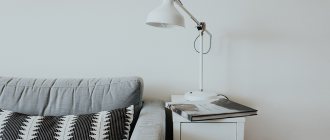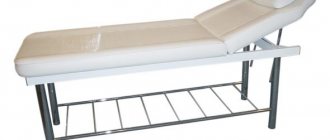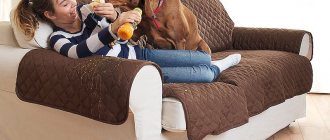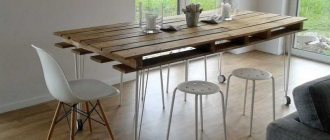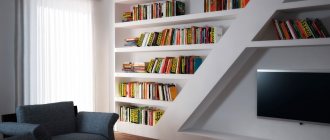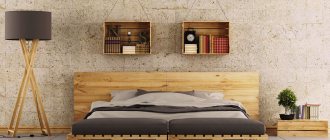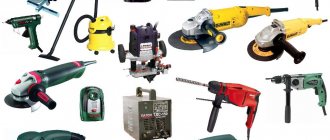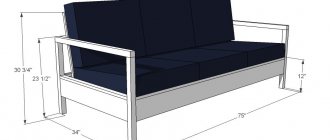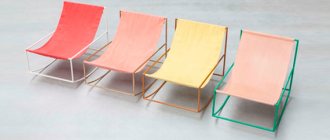This way you can save your own savings on the purchase of expensive furniture items, make an original design of the sofa, and independently select the materials for its manufacture. Furniture made according to an individual project will harmoniously fit into the interior of the room and become its main decoration.
Peculiarities
Everyone knows that a sofa plays an important role in any residential or non-residential premises. On it, people receive guests, relax in the company of their nearest and dearest while watching TV or playing board games, and sleep at night.
Recently, instead of the usual straight models, people prefer to install corner sofas, which are distinguished by functionality and rational use of free space. Before you start making a sofa, you need to decide on its:
- Appointment. Think in advance about which room the product will be placed in. The dimensions and design of the furniture will directly depend on this. A corner sofa can be built for a comfortable family time in the living room, or you can make a small product for the kitchen.
Shape and size.
Here it is worth starting only from personal wishes and preferences, as well as from the features of the room where it will stand. For small rooms it is better to make compact and ergonomic models, and in a spacious living room it is worth installing a roomy and large corner sofa. As for the shape, it can be varied: in the form of the letter L, U-shaped, with or without armrests.- Filler. As a rule, foam rubber, padding polyester and holofiber are used as filler for upholstered furniture . Their choice must be taken with full responsibility. Here, the thickness of the material, its density, elasticity and resilience, as well as rigidity play an important role.
- Functionality. Some consumers prefer furniture with spacious drawers where they can store bedding or personal items. Also, corner sofas are often equipped with shelves and bookcases.
Calculation of profit from production
By making one corner sofa according to our video course, you can earn from 13,500 rubles by selling it, for example, on Avito for 30,000 rubles. This is a competitive price, as it is lower than the store price.
If you are a beginner, it will take you about a week to make alone:
- 1 day to buy all materials and accessories according to the list;
- 1 day to saw the parts and assemble the frame from them;
- 1 day to foam the frame elements;
- 4 days to sew the patterns and cover the frames.
By making the second and subsequent sofas, the manufacturing time will be reduced by approximately half. It takes the author of the course about 4 days.
To calculate profit, enter your data and press Enter or Tab. Prices are indicated in rubles, but you can enter prices in your currency.
Wood or pallet frame?
Having decided to make a corner sofa, people must competently approach the choice of materials. They must be environmentally friendly, safe, durable and easy to use.
Advice: for beginners in carpentry, you should avoid materials such as laminated boards and large-section timber. Because they are expensive and difficult to process.
As for the variety of materials from which a sofa frame can be made, these include:
Pallets.
This material is budget-friendly. The process of making a corner sofa from pallets will take a minimum of free time. As a result, you will get an original model that harmoniously fits into loft, Provence or minimalism styles.- Beam. It is used in the manufacture of load-bearing parts of the frame. Glued laminated timber is most often used to create sidewalls . Its advantages include a perfectly smooth surface, ease of use and high technical performance.
- Plywood. It is of high quality, durable and easy to use. The unique properties of plywood are directly related to its production. Thanks to a special technology for gluing veneer sheets, the material has high strength. Plywood is much stronger than timber . Frames made from it do not deform during long-term use, do not absorb moisture, and do not dry out.
Natural array.
This type of furniture is a classic and is in great demand. Wooden furniture looks harmonious in different interiors. It is distinguished by its naturalness, environmental friendliness, aesthetics and long service life. You can make a sofa frame from different types of wood: birch, pine, oak, larch, beech, walnut, ash. Each individual option has its own advantages and technical characteristics.The frame of a pine sofa, although it has an affordable price, will not please its owners with its high quality. It is quite difficult to find high quality wood on the market. Because of this, the sofa will quickly fail and lose its attractive appearance. To prevent mold and fungi from appearing on the product, you must choose well-dried wood. Birch in the manufacture of frames is also affordable in terms of price, but has higher quality indicators . Such products will turn out to be quite durable and reliable.
Help : the most reliable and durable are sofas whose frame is made of timber and plywood or only plywood. If you plan to make a large model, then it is recommended to make the bottom bar of the product from wood or chipboard.
Cast iron bath sofa
If you decide to replace your old metal bathtub with a modern acrylic one, do not rush to throw it away. An old bathtub can also be turned into a sofa, and a very unusual one that will surprise all your guests.
Sofa from an old bath
Of course, this idea is not suitable for everyone, and for various reasons.
- Firstly, the work ahead will be long, dusty and quite difficult.
- Secondly, the furniture with small dimensions will turn out to be very heavy if the bathtub is cast iron, and unusually cold.
- And thirdly, such a sofa will not fit into every interior.
Sofa from the movie "Breakfast at Tiffany's"
If none of the above scares you, let's get started.
Old bath
- After dismantling the bathtub, we outline a smooth outline of the front part of the sofa on one of the walls.
- Cut out the excess part with a grinder.
Angle grinders (grinders)
- Having replaced the cutting wheel with a grinding wheel, use the same grinder to smooth and level the cut.
- We remove the legs and thoroughly clean both them and the bathtub itself, if necessary using chemicals or a grinding tool. It is necessary to achieve a flat and relatively smooth surface.
- Then we putty on rough defects and cover the bathtub with primer.
- We paint it in the desired color, applying several layers of paint, drying and sanding each layer.
- We install the bathtub on restored and painted legs.
- We make a mattress from foam rubber covered in a cover, sew small pillows under the back - and the sofa is ready.
Upholstery selection
When it comes to textiles, there are no limits to your imagination. The most common and popular upholstery materials are:
Velveteen. The fabric has a velvet texture, which is pleasant and soft to the touch. The material attracts buyers with its pleasant shimmer and high density .
As a rule, when upholstering upholstered furniture with corduroy, consumers give preference to plain materials or with checkered and striped prints. When stains appear on the surface, they can be easily and simply removed using stain removers.- Chenille. It has unique strength. Therefore, it is often used as upholstery for upholstered furniture. This material is warm and pleasant to the touch. It can be easily cleaned from stains with vinegar or alcohol.
- Flock. It is considered the most durable, reliable, environmentally friendly and beautiful material. In appearance, flock is similar to velvet. It is half made of synthetic fibers, therefore easy to clean and durable.
- Jacquard. Dense and elegant fabric, characterized by a specific weaving thread. It does not fade in the sun, is not subject to abrasion, and retains its bright colors for many years.
- Tapestry. Its technical characteristics are similar to jacquard. This fabric is reversible. Its advantages include strength and wear resistance. The presence of a special impregnation on the material prevents the appearance of stains and dirt .
Natural or artificial leather.
Although genuine leather has a high cost, it is distinguished by its strength, durability, and scratch resistance. This material breathes on its own, mold does not form on its surface, and is resistant to temperature changes. Leatherette costs much less, but is in no way inferior in technical qualities. Ornaments and patterns are applied to it, and the material goes on sale in a wide color palette.
All of the above materials have such positive qualities as:
- hypoallergenic;
- breathability;
- environmental friendliness;
- durability.
Types of sofas
You need to remember that a sofa and a bed are not the same thing. The first one has a soft backrest , while the second one does not. In the classic version, the sofa also has soft armrests. But some modern models do not have armrests. And the backrest can turn into an additional sleeping place by turning it around. This is the so-called “Eurobook”. And she has the right to live with a homemade master.
The sofa can be made either from ready-made material, which can be bought at any construction market, or from improvised materials. Old bathtubs, tractor tires, and wooden Euro pallets are used.
Euro pallets
Pallets have long been popular among do-it-yourselfers. These are unique modules from which in a very short time and at minimal cost you can make a chic sofa in the loft style .
To work with Euro pallets you need screws, a screwdriver and a jigsaw. If you don’t have a power tool, you can get by with a simple screwdriver and a hacksaw. But in this case, the work will be physically harder and will take longer.
When assembling such a sofa, a drawing is not needed. Everything is very simple. A pair of pallets is used for the base. One is placed on top of the other and secured with screws. Then this finished pair is attached to another similar one. The base is ready. For the armrests, you need to cut a couple of pallets at the level of the wooden inserts , or, as they are called, “bobs.” These pieces of pallets are attached to the edges of the finished base. It should be noted that this type of furniture does not fold out and does not have a back. Instead, there are a couple of soft pillows. A mattress is made from thick foam rubber and placed on the base.
If you can’t make covers for foam rubber at home and don’t want to go to a sewing workshop, using a stapler you can easily stretch the upholstery fabric onto the foam rubber right on the sofa with your own hands.
Old bath
The manufacturing scheme is also simple. Use a grinder to cut off one side of the bathtub. It turns out the back and sides. The same foam rubber is placed inside. From above everything is covered with a thin layer of foam rubber and upholstery. You can use a sewn cover. This type of sofa is used, as a rule, in a garden or summer cottage.
Tractor tire
Instead of a base, you can also use an old tractor tire . For the back, we take five or six wooden blocks and attach them to the rubber with self-tapping screws at equal distances. We cover the tire with fabric. For the backrest we prepare a foam mattress, which we attach to the bars. Cut a piece of plywood to cover the hole. Again, we put foam rubber on it and decorate it with fabric. To make it easier to move this homemade furniture, you need to make a stand on wheels.
Drawing
In order to avoid problems when cutting and assembling parts during the manufacturing of a corner sofa, it is necessary to make a preliminary drawing of the future product. It will need to indicate the dimensions of all individual elements, methods of attaching them to each other and materials of manufacture. You can make a drawing in different ways:
- Draw your own version of the furniture on a piece of paper. In this case, you need to be able to calculate dimensions and draw in different projections.
- Find the best option on the Internet and modify it in your own way. This is the easiest way when you can choose an original design with all sizes and mounting methods.
- Use a special program on your computer. In this case, you need to be able to work with the cutting program. As a result, you will get a diagram in all variations and with the designation of all elements.
It is necessary to indicate on the drawing:
- the dimensions of the sofa and the overall dimensions of all components;
- back angle;
- when manufacturing a folding model, it is necessary to specify the transformation mechanism;
- thickness and hardness of upholstery.
Attention : when creating a drawing, it is necessary to take into account the projections of all working units of the furniture item. Therefore, you cannot do without the ability to work with computer programs or the basics of drawing.
What is the structure of the sofa made of?
Before you begin the repair, you need to familiarize yourself with the elements that make up the design of the sofa:
A wooden frame, which also consists of plywood parts. It is worth noting that a plywood base will be more reliable, but it is much more difficult to manufacture, so pine bars are often used to create the frame, connecting them together with wood glue.
Base for spring block. In this case, the base can be a type of lamellas (cross bars) or fiberboard. The first option is usually installed in more expensive sofa models. Thus, the lamellas in all modern products are fixed to plastic stops, which quickly fail. In addition, they can also become deformed, because in order to reduce the cost of the sofa, manufacturers often lay them with too large a gap, which does not meet the standards. Over time, due to such negligence, holes form in the seat. Spring block. Springs also differ from each other; they can be dependent or independent types. The second option will be more comfortable, but correspondingly more expensive.
Dense material (felt is often used), thanks to which the springs do not deform the foam. Foam rubber. In the process of making sofas, dense, furniture-grade foam is usually used. Accordingly, the greater its thickness, the more expensive the product will be. You can independently increase the thickness of the foam rubber only if you do not have a folding structure in front of you. Sintepon, which is fixed on top of the foam rubber with glue. This is necessary so that the upholstery does not rub the soft part. Upholstery
The upholstery material can be different, and if it needs to be replaced, it is important to choose an option that is suitable in terms of density.
The sofa consists of much larger elements than one might expect
If we are talking about a folding sofa, then the design also includes a transformation mechanism. There are several types of such mechanisms, and we will tell you more about the most popular ones in the table.
Table 1. Types of transformation mechanisms
| Type, illustration | Description |
Click-clack | Such a mechanism assumes the presence of three provisions. It is often installed on modern types of sofas with slats. |
Meralax | Thanks to the installation of such a mechanism, you can achieve a massage effect when sitting or lying down. Meralax can be metal or in the form of wooden planks. |
Dolphin | This is not a bulky, but at the same time very convenient to use mechanism. A seat is fixed to the side of the frame, which will then move apart. This is the simplest mechanism of all existing options, but at the same time it is reliable. |
Accordion | This mechanism also suggests the presence of three folding options. Its main part is static, others move and are fixed with locks. The accordion is installed in various modern products; it cannot be found in old furniture. |
Tools and materials
To make a corner sofa you will need to prepare the following materials:
Laminated chipboard or fiberboard for creating the bottom of drawers.- Legs for a sofa. These can be both purchased products and those made independently from timber. But there must be at least 9 of them.
- When making a folding model, you need to buy a folding mechanism.
- Filler. This role can be played by foam rubber, holofiber, padding polyester.
- Threads and fabric for upholstery.
- Self-tapping screws, screws and other fastening elements.
Tools you will need:
- screwdriver or electric drill;
- wood hacksaw or hand saw;
- sewing machine for sewing covers;
- upholstery stapler.
DIY corner sofa for the kitchen
The standard set of furniture for arranging a dining area includes a table, a corner sofa and stools.
According to the step-by-step instructions, to make a corner sofa for the kitchen, you will need:
- Board made of birch, beech or pine 2 by 4 cm - 100 cm.
- Beam with a section of 4 by 4 cm, about 135 cm.
- The beam is 2.5 by 2.4 cm, about 365 cm.
- Beam 1.5 by 1.5 cm thick - 300 cm. For covering the back wall, a sheet of fiberboard.
- Plywood 0.8 - 1 cm thick for the bottom and sides.
- You also need 5 cm thick foam rubber or padding polyester.
- Upholstery fabric (microfiber, tapestry, leather, nubuck and others).
To make a corner sofa for the kitchen with your own hands, prepare:
- jigsaw
- carpenter's corner
- plane
- furniture stapler
- screwdriver
- Sander
- drill
- bit
- hacksaw
- pliers
- roulette
- hammer
You will also need: confirmations, screws 0.4 by 2 cm, 0.4 by 6 cm and 0.4 by 8 cm, bolts and 0.8 cm washers, dowels, legs, hinges. If you plan to make a folding sofa with your own hands, then according to the instructions, you need a special mechanism. The drawing of the sofa for the kitchen should indicate the calculated dimensions and dimensions. In this case, your kitchen corner will fit perfectly into the dimensions of the room.
The workpieces are sanded and leveled, and only then can they be marked and sawed. The average length of a corner sofa is 120 by 90 cm, the corner insert is 45 by 45 cm, and the back height is 85.5 cm.
First, according to the drawings, the main parts of the sofa from the kitchen corner are made - these are the sides. They are made from a thick sheet of plywood. The markings are made with a pencil, and then the part of the kitchen corner sofa is cut out along the lines with a jigsaw.
The next step is to make two frames from 4 by 4 centimeter beams for both sides of the sofa. Both frames should be in the form of parallelepipeds, which are then fixed to the sidewalls. The connections at the corners should look like a mustache and a spike, which are subsequently glued. The T and L shape connections should be at a 90 degree angle.
At the corners, the connections can be with through holes or hidden, go into half of the beam, and also have one, two, or three tenons. They are secured with dowels or corners with self-tapping screws.
The frame of the corner sofa for the kitchen is connected to the back and secured on the sides. When the base is ready, you can assemble the hinged seat covers. Seats can be solid or sectional.
How to make a wooden shelf with your own hands read more
Rectangular frames for seats are made from a block 2.5 by 2.5 centimeters thick. Then they are sewn up with centimeter plywood. The seats are cleaned and covered with a layer of stain and varnish. Then foam rubber is glued and the fabric is stuffed.
A piano loop is attached to the long part of the corner sofa seats. Fastening the hinged covers is done at the end of the work. The corner module is assembled in the same way. A frame is made from a 4 by 4 centimeter block. The profile should be triangular in shape and have sides at angles of 45 and 90 degrees. The module is covered with plywood.
The assembled two parts of the sofas and the corner module are sanded. Exposed wooden elements are covered with stain and, accordingly, three layers of varnish on top. All parts are placed on the sofa legs and fastened together. The connection takes place using screws to the frame support. There must be at least 8 legs.
Structural details are adjusted when adjusting the height of the legs. Marks are made in the places of future fastening. Holes for bolts with a diameter of 0.8 centimeters are drilled. Bolts and washers for them should have wide margins. There should be twice as many washers as there are bolts, so that one goes under the bolt and the other goes under the nut.
The upholstery fabric depends on the proximity of the sofa to the stove and sink. The surface should be easy to clean and not exposed to chemicals.
For a small-sized sofa, 5 cm foam rubber is suitable. For a semi-soft corner of a larger size, padding is taken from padding polyester. Foam rubber or padding polyester is glued to the back with glue. The fabric is cut out according to patterns and stapled to the back of the back, as well as at the junction of the back with the seat. The material is stretched and securely fastened at the corners. Then it is fixed around the entire perimeter.
Assembly diagram step by step
The general assembly diagram for a corner sofa will look like this:
- First, the armrests are assembled from timber and foam rubber.
- The frame of the left part of the product is mounted.
- The right side frame is assembled.
- Upholstery work is being carried out.
More detailed instructions for making and assembling a soft corner sofa for the living room or bedroom are as follows.
How to make armrests?
A corner sofa requires the manufacture of two mirrored armrests. Their length should be 90 cm, width – 20 cm, height – 55 cm. To make the armrests, take chipboard and 2 beams. The screws will be screwed from the chipboard into the timber in increments of every 20 cm .
The top and bottom of the armrests are cut out of chipboard and attached to wooden slats. Next, vertical support bars are installed on top and bottom of the sidewalls. As a result, you should get some kind of box, which will have one side, top, bottom and an open front wall with vertical elements. Now the armrests can be covered with foam rubber.
Right part
Next, according to the drawing, the remaining parts of the box are cut out and fixed with nails. To give the frame strength, you can additionally glue all fastening elements.
On the inside of the sidewall, in the place where the seat will be located, a chipboard overlay is installed. All sides of the product are covered with foam rubber, except for the back wall .
Now a second armrest is made, which is a mirror image of the first. The seat side and back are made from chipboard. The elements are fastened together with plywood.
We make two more similar parts for the second part and fasten them together in the same way. A vertical beam is screwed to the two sidewalls.
Important : To strengthen the structure, it is recommended to reinforce the rear wall with vertical support bars.
Let's move on to assembling the frame for the inclined back. For this, a support frame and two vertical slats are used. The manufactured frame must fit tightly into the previously assembled frame.
Now the seat is made from plywood. The thickness of the plywood must be at least 8 mm. The seat is installed on the frame only after it has been covered with foam rubber and upholstered with fabric.
Left side
Now let's start assembling the left side. This process is complicated by the presence of linen drawers. The left side of the sofa is assembled according to the same pattern.
First, the necessary sidewall parts are made from chipboard and fastened together with plywood and timber. All blanks are mounted on a frame and reinforced with vertical bars . Next, a frame for the backrest is made and a lifting mechanism is installed. The assembled frame is covered with foam rubber and covered with fabric.
Step-by-step instructions for upholstery
As for the finishing of the corner sofa, it is worth including the process of upholstering the product with materials. Work is carried out in the following sequence:
First, measurements are taken of all the parts that will be covered with materials and they are cut.- Before upholstery, all elements of the sofa are covered with foam rubber and padding polyester.
Since foam rubber will quickly lose its shape upon contact with fabric. A padding polyester layer will prevent wear of the foam rubber and make the seat and back softer and more comfortable to use . - The armrests are covered not with padding polyester, but with non-woven materials, for example, agrotextiles or spunbond.
- Three additional pillows must be placed on the back of the seat. Their inner cover is made of non-woven material, and the outer cover is made of beautiful and practical fabric.
Important : when cutting, you need to make allowances of a few centimeters on each side. Therefore, experts recommend not cutting out all the fabric at once. First, work is carried out on one part in order to understand how many centimeters should be left for allowances.
Tip : for the bedroom you can try making a couch, ottoman or sofa. And next to the sofa, a coffee or glass table or even an ottoman will look good.
Corner sofas in the interior
The corner sofa is gaining more and more popularity due to the possibility of rational use of the useful space of the apartment, especially such rarely used space as a corner and a window sill. They look beautiful in any interior and are often equipped with spacious linen drawers and transformation mechanisms that allow you to turn them into a comfortable bed at the right time.
Corner sofas have been deservedly used in kitchens for a long time. With their help, it is convenient and effective to divide the space of combined rooms, such as a kitchen, dining room, living room or bedroom.
For owners of small apartments, such pieces of furniture will allow you to get in one piece a comfortable and roomy sofa for 5 seats or more, an extra bed and a drawer for storing linen or rarely used items.
Many craftsmen make corner sofas with their own hands. After all, for those who want to acquire such a product, purchasing a factory-made product may require large financial costs. In addition, often the room does not accommodate standard models.
Photo
The results of the work may look the same as in the photos presented:
Folding mechanisms
Almost all sofas (except kitchen ones) are made with a folding bed. The difference is not only in size, but also in the type of mechanism used. Not only convenience, but also the direction in which the berth is unfolded depends on this.
A corner sofa for a children's room can be in the form of a cartoon character
Eurobook
One of the most popular mechanisms, and all its charms are manifested precisely in corner sofas - the seat can quickly and easily be transformed into a large sleeping place. The seat moves forward and the backrest falls into the vacant space.
Simple and reliable mechanism. There is only one point: the retractable part must be on wheels. Moreover, it is better if they are wider, otherwise there is a high possibility of damaging the floor covering.
Pantograph or "tick-tock"
Modification of the Eurobook. The frame of the folding structure is made of metal, with additional springs added to it, so that it turns out that the folding part first rises a little upward, then falls down in an arc. Further, the process is also simple - the backrest is lowered into the vacant space. In this design, wheels are not needed, since the folding part does not move on the floor.
The mechanism is more expensive, but is suitable for use on soft floor coverings and does not harm them at all. This folding method is suitable for daily use and does not require much effort. Even a child can cope.
Dolphin
This mechanism for transforming a sofa into a sleeping place appeared a long time ago. The transformation occurs in two stages:
- An additional part of the berth extends from the bottom of the sofa.
- With a little effort, it rises to the same level as the stationary part.
The mechanism is simple and reliable, but it must be pulled with sufficient force. Suitable for daily use. The linen drawer in such a corner sofa can only be in the side part.
Corner sofa with folding mechanism “Accordion”
One of the popular mechanisms of folding sofas is the accordion. It unfolds in one motion - you use special hinges to pull the seat towards you. In this case, the seat moves forward and the backrest unfolds.
The mechanism is reliable, easy to maintain, and can be used every day. But there is a significant drawback - significant effort is required to activate it. Essentially you are pulling most of the sofa. One more point: this mechanism is incompatible with spring blocks of any type.
Sedaflex or French folding bed
This mechanism is only suitable for guest sofas - it is not recommended to use it every day. Firstly, it is not very convenient, and secondly, the mechanism is not designed for this. It unfolds in several steps:
- Remove the cushions from the seat.
- Raise the seat up and slightly towards you. It becomes supported.
- Unfold the last part of the lounger, lower it down, while straightening the legs.
It’s not very convenient, and significant effort is required at the second stage. What’s good is that this mechanism is compatible with spring blocks.
Non-standard options
Some factories make corner sofas with non-standard folding mechanisms. Some cannot even be called mechanisms - one or two parts are mounted on wheels, so they simply move to the right place.
There are also transforming sofas, but this is a different price category, since the transformations are complex and the mechanisms used are more expensive. For example, this mechanism is called “scissors”
Read more about transformable furniture here.
How to make a Chester sofa
To do the job you will need the following tools:
- hand circular saw;
- jigsaw;
- stapler (preferably pneumatic, but if there is no compressor, then you will have to work manually);
- drill;
- screwdriver;
- marker and pencil;
- ruler and tape measure.
This standard set of tools will be necessary when making any sofa.
So, you should prepare all the blanks and cut grooves into them in accordance with the presented sketches.
The assembly diagram is presented with a series of photographs, sequentially showing the stages of the work.
Inserting the workpieces into the pre-sawed grooves, we secure them with self-tapping screws.
First, crossbars coated with PVA glue are attached to the racks.
The holders are screwed to the rail with self-tapping screws and fixed with brackets, after which the part is fixed to the frame.
The armrests and the front part of the sofa are upholstered with fiberboard.
We draw a center line and mark 14.5 cm on it - this is how the markings are made for the buttons, which will then be installed. Then, using a feather drill, holes are drilled in the marked places.
Next, we will attach the grosgrain ribbon, which should be located strictly above the hole, going down vertically.
After covering it with fabric, we begin gluing the foam rubber to the frame. In those places where gluing is inconvenient, you can shoot the foam rubber with a stapler.
Now let's draw up two sketches, taking the necessary measurements.
First, measure the distance from the top button to the side bar. We do the same with the back - from the button to the back bar. You also need to measure the distance from the front pillar to the first top button on the armrest. We put all these dimensions into the sketch.
- Size L is the length of the arc from the button to the top bar.
- L+50 is 50 mm to shoot.
- 155 is the distance between the rows.
- These data are not final, as they will still change.
- 195 is the size between the buttons horizontally. On the bar it was 145mm but now has 50mm added for the pleats.
- Each row comes with an offset of 97.5 mm.
- Green shows an edge allowance of 50 mm.
- Bottom distance N is the distance from the bottom button to the allowance block.
Taking into account all these dimensions, we get the dimensions we need.
In the second picture we see that there is also a distance B from the front bar to the top outer button.
After receiving these dimensions, we transfer it all to the fabric.
Now let's make the carriage tie. You can find out how to make it correctly, and how you can do without a press for making buttons, by watching the following video.
Video: correct and incorrect carriage tie
Now we need to make a mattress. To do this, a snake spring is attached to the base, and a dense woven material is placed on top of it. Then a coconut trunk is laid, then 35 (or 42) density foam rubber 10 cm thick. We lay padding polyester on top, and only after that can we start covering the sofa with fabric (or leather).
Such a sofa will be comfortable, beautiful and durable.
By viewing the following slide show, you can watch the assembly process of a similar design.
Video: sofa assembly process
As you have already noticed, the work cannot be called easy, so without experience it will not be easy to make a high-quality Chester sofa.
How to sew a cover
Making the body of a sofa is already a lot, but it is also important to trim it beautifully. Considering the fact that the fabric is expensive and cannot be bought in reserve, it is important to make the right patterns and sew a cover from them.
Which fabric to choose?
Depending on where and under what conditions the sofa will be used, a suitable fabric is selected. Let's look at a few examples.
| Where is the sofa | Type of fabric |
| In the living room, the sofa is often used, and not only by people living in the apartment. Guests often sit on it while eating, so there is a high probability that a cutlet or a piece of fish in vegetable oil will fall on it. Taking this into account, it is better to use synthetic fabrics, since they practically do not absorb moisture, including fats, and they wash well. | |
| In the bedroom, the sofa is used to sleep on or just relax. Instead of synthetic fabrics, it is better to use natural materials, or those containing at least 50% natural fibers. Flock is often used, as this type of fabric is durable, does not cause allergies and does not lint. | |
| If you are concerned about your child's health, it is better to use cotton fabrics that do not cause allergies. This type of cladding has one significant drawback - it gets dirty easily, which makes it impractical. The quality of the fabric can be improved by using Teflon impregnation. | |
| In the area where you regularly eat, there is a high probability of contamination of the sofa upholstery with food products. Using fabric is impractical and unprofitable, so it is better to use high-quality leatherette, which is made specifically for these purposes. Low-quality leatherette will very soon begin to peel off from the base. |
How to cut
When repairing an old sofa, you can use the removed fabric as a pattern, but when upholstering a new sofa you will have to cut it yourself. How to make the right pattern?
Covering with a single piece of fabric
This technology has already been briefly mentioned in the article, but now we will describe the entire process in detail. For example, we will use a sofa seat and instead of a single piece of fabric, we will demonstrate it using a piece that was left after sewing the cover.
So, in order to upholster a separate element of upholstered furniture, you need to cut a piece of fabric that could be used to wrap the piece so that the edges can be secured from below.
Having stretched the fabric onto the parts, it needs to be stapled in front and behind. Then the hanging corner at the front is pulled tight and secured at the bottom. The fabric is laid out in folds so that they converge at one point and nailed with staples.
The back of the seat will be turned towards the wall, so you can not lay it out, but simply fold it, leaving the excess inside, and secure it in this state.
Sewing a cover for a non-folding sofa
The described technology will allow an inexperienced person to cut and sew a cover not only for a new, but also for an old sofa.
Sewing this cover took 3.5 meters of fabric and a spool of thread.
So, you need to throw the fabric over the sofa, wrong side up, positioning it in the same way as the finished cover will be located.
We will put marks so that we can then cut the fabric according to them.
In these places we cut the fabric all the way to the sofa.
The seat piece needs to be fastened to the back fabric.
Using needles, you need to pin the fabric along all the supposed seams. Instead of needles, you can use pins or sew with a basting stitch.
Next we apply the future frill, which will be gathered into folds.
Having fastened all parts of the cover, remove it.
After basting the seams, put the cover on the sofa - it should fit without much effort, fitting the product being covered. If it turns out to be too tight or too loose, then this needs to be corrected by removing it.
Now you can sew the cover.
Then a frill is sewn onto it. If the cover is intended for upholstery of a sofa, then there is no need to sew on the frill, as it will be inconvenient to fix the fabric. The frill can be nailed on later if the need arises.
The result is such a cute sofa. Based on this example, you can cover any sofa, but for a new one it is better to sew separate covers for the back and seat.
As you can see, making a sofa and upholstering it at home is quite possible.

